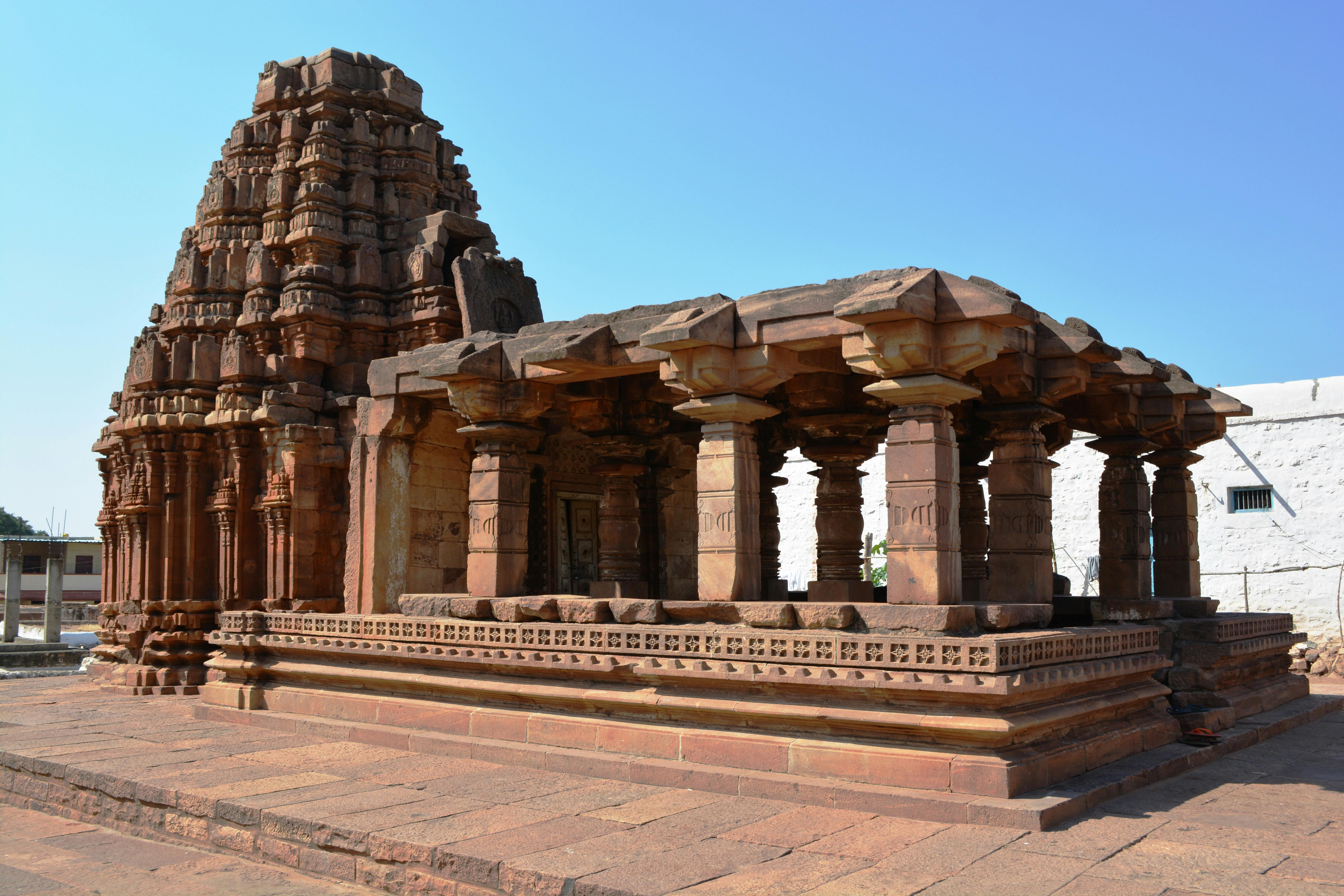Incredible South with Deccan India

Detailed Itinerary
Day 1Arrive Delhi
Arrive by International flight, after traditional Indian style ‘Swagat’ (Welcome) by Exceptional Escapes representative, he would assist you at the airport & transfer to hotel for check in.
Mumbai is an archipelago of seven islands. Artifacts found that these islands had been inhabited since the Stone Age & documented evidence of human habitation dates back to 250 BC. In the 3rd century BC, the islands formed part of the Maurya Empire. In 1534, Portuguese appropriated islands from king of Gujarat later ceded to Charles II of England in 1661, as dowry for Catherine de Braganza. These islands were in turn leased to the British East India Company in 1668.
Overnight Hotel – Mumbai
Day 2Mumbai
Post breakfast Guided city of Mumbi;
Gateway of India, the entrance to the port of Mumbai. It was built to commemorate the visit of King George V in 1911.
Prince Wales Museum, built in a confluence of Gothic & Moorish styles. It boasts a collection of ancient Indus Valley artifacts dating 2000 BC, plus some priceless Tibetan & Nepali Art.
Elephanta Caves, houses rock cut temples dating back to 5th century CE. It was named by the Portuguese, after the statue of an elephant near the landing area of the island.
Marine Drive, which runs along the shore of Arabian Sea from Nariman Point past Chowpatty Beach to the foot of Malabar Hill.
A unique feature of Mumbai Dhobi Ghat; is a traditional laundryman, who will collect dirty linen, wash it, and return it neatly pressed to your doorstep. All for a pittance. The "laundries" are called "Ghats": row upon row of concrete wash pens, each fitted with its own flogging stone. The clothes are soaked in sudsy water, thrashed on the flogging stones, then tossed into huge vats of boiling starch and hung out to dry. Next they are ironed and piled into neat bundles.
Rest of the time FREE.
Overnight Hotel – Mumbai (B)
Day 3Mumbai – Aurangabad {9W313@ 0515/0615 Hrs}
Early wakeup would tough to board the flight to Aurangabad but you will forget everything once you will reach Ajanta Cave. Aurangabad; a village named Kirki where the city stands today. According to some historians, the city was founded in the year 1610 by Malik Ambar. He was the Prime Minister of Murtaza Nizam Shah II of Ahmednagar, the then ruler of the Deccan (central parts of Southern India). In the year 1634, Aurangzeb was sent to Kirki as Governor of Deccan. In 1644, he moved to Agra to play an active role in Mughal politics. In 1681, the city again became the residence of Aurangzeb, who had now become Mughal Emperor. He lived there until his death in 1707. The modern name of the city was probably taken after his death.
Later Guide visit the Ajanta Caves (Closed on Monday) Nestling in an inner fold of the Sahyadri hills, 100 km from Aurangabad in the shape of a mammoth horse- shoe, are the 30 rock-hewn caves of Ajanta. The Caves date from the 2nd century BC. Discovered in 1819 by a group of British army officers, these startling achievements took around 600 years to create. Ajanta Caves have been an UNESCO World Heritage Site specifically nominated for the international World Heritage program.
Drive back to Aurangabad.
Evening FREE.
Overnight Hotel – Mumbai (B)
Day 4
Aurangabad – Hyderabad (2T-104 @ 1315 / 1435 Hrs)
After early breakfast proceed to visit Ellora Caves (Closed on Tuesday) these enchanting caves were built in the time period between 5th and 10th century AD by the rulers of the Rashtrakuta Dynasty. They were built out of the vertical face of the Charanandri Hills and are 108 km from Ajanta Caves. The cave complex consists of 34 caves representing the three different religions of the world- Buddhism, Hinduism and Jainism which is a proof that religious harmony existed during that time. It is also a World Heritage Site. There are temples as well as the monasteries inside the cave complex. The Kailash Temple dedicated to Lord Shiva inside cave 16 is the largest monolithic structure in the whole world. In the noon transfer to airport to board the flight to Hyderabad; It is known for its rich history, culture & architecture representing its unique characteristic of a meeting point for northern & southern India, & its multi-lingual culture, both geographically & culturally. The place has always been a place where Hindus & Muslims have co-existed peacefully for centuries. Hyderabad & rest of the Telangana has unique culture of its own in comparison to coastal & Rayalseema regions of Andhra Pradesh.
Evening at leisure.
Overnight Hotel – Hyderabad (B)
Day 5Hyderabad
Post breakfast guided city tour of Hyderabad visiting Charminar, Hussain Sagar, Salar Jung Museum with its largest private collections of the Nizams. Other important attractions in the city include State Central Library (one of the best libraries in India), Naubat Pahad (a hilltop spot) & the Osmania University.
Post lunch visit the Ramoji Film City; a magical realm filled with excitement and wonderful surprises at every turn. As the world’s largest integrated film city and india’s only thematic holiday destination with magic of cinema, there’s something special for you here.Spread across a sprawling 2000 acres Ramoji Film City, set up by Ramoji Group in 1996, is a dreamy celluloid journey. Certified by the Guinness World Records as the world’s largest Filmstudio complex, at Ramoji Film City, a filmmaker can walk with a script and walk out with film.
Rest of the day at leisure to explore the city.
Overnight Hotel – Hyderabad (B)
Day 6Hyderabad – Gulbarga via Bidar (250 kms - 05 Hrs) Bidar – Gulbarga (110 km – 02hr)
Post breakfast drive to Bidar -a tiny district steeped in history. The Fort, the Cannons, Palaces in ruins, the magnificent tombs & the massive monuments, all combine to make a visit to the one-time capital of the Bahamani & Barid Shahi dynasties.
Post lunch drive to Gulbarga, history of it dates back to the 6th century when the Rashtrakutas gained control over the area, but the Chalukyas regained their domain & reigned for over two hundred years. The Kalachuris who succeeded them ruled till the 12th century. Around the close of the 12th century the Yadavas of Devgiri & the Hoysala of Helebid took control of the district. About the same period the Kakatiya kings of Warangal came into prominence. The present Gulbarga & Raichur districts formed part of their domain. With the conquest of the Deccan by Aurangzeb in the 17th Century, control of Gulbarga passed to the Mughal Empire.
Overnight Hotel – Gulbarga (B)
Day 7Gulbarga – Bijapur (150km – 03 Hrs)
Post breakfast half-day guided city tour Gulbarga, a Hindu city before the Mohammedan conquest, Gulbarga is a unique synthesis of two cultures. The most important monument in Gulbarga is probably the Khwaja Bande Nawaz Dargah. The tomb of the great Sufi saint, Khwaja Syed Mohammead Gesu Daraz Also visit the Gulbarga Fort, is a magnificent structure with 15 towers & 26 guns. To the southern entrance of the fort is a group of royal tombs. Inside the fort is the Jumma Masjid, built on the lines of the great Mosque of Cordova of Spain.
Post lunch drive Bijapur, city is well known for the great architectures of historical importance built during the Adil Shahi dynasty. The city established in the 10th-11th centuries by the Chalukyas of Kalyani was referred as Vijayapura (City of victory). The city came under the influence of the Khilji Sultanate in Delhi by the late 13th century. In 1347, the area was conquered by the Bahmani Sultanate of Gulbarga. By this time the city was being referred as Vijapur or Bijapur.
Evening Free at leisure.
Overnight Hotel – Bijapur (B)
Day 8Bijapur – Badami (135kms / 03 Hrs)
Post breakfast half day guided tour of Bijapur;
Gol Gumbaz, tomb of Mohammed Adil Shah, the interior of the dome is mysteriously unsupported & has a whispering gallery under it, whose acoustics are superb. Adil Shah began the task of building his own tomb, quite earnestly & went on with this work for over 20 years.
Jumma Masjid; is the other attraction of this city. Jumma Masjid still used for worship has been called one of the first mosques in India. Also visit Ibrahim Roza, a beautiful tomb with artistically laid out corridors & interconnecting buildings with richly decorated walls & perforated stone windows. Ibrahim Roza, the mausoleum of Ibrahim Adil Shah II, is said to have inspired the Taj Mahal in Agra.
Post lunch drive to Badami, founded by Pulakesi I, ruler of the Chalukyas, the town is located at the foot of a rugged, red sandstone outcrop that surrounds Agastya tirtha water reservoir on three sides & is known for its rock-cut cave temples, sculpted between 6th -8th century AD.
Rest of the time FREE for relax.
Overnight Hotel – Badami.
Day 9Badami
Post breakfast proceed to visit Badami, several temples dating from the Chalukyas period in Badami. First set of temples is a group of fouron a hill adjacent to the Bhutanatha tank, are dating back to the 5th century CE. In the adjacent wall there is a carving of the cosmic dance of Shiva Natarajan depicted with eighteen arms. 2nd temple images of Vishnu in his Varaha & Trivikrama incarnations. 3rd rock cut temple with inscriptions dating this Vishnu temple to 578 CE during, the period of Kiritivarma Chalukyas. There are carved images of the Narasimha & Trivikrama avataras of Vishnu.
Later visit the Jain rock cut temple dedicated to the Tirthankara Adinath with inscriptions dating back to the 12th century. The Mallikarjuna temple dating 11th century on a star shaped plan.
Rest of the time FREE for relax.
Overnight Hotel – Badami (B)
Day 10Badami – Hospet (166 Kms – 03 Hrs)
Post breakfast drive to Hospet, once a beautiful capital city of Vijaynagar empire, in ancient days was known as Nagalapura. The city was razed to the ground by Sultan of South India in the year 1565.
En route visit Pattadakkal & Ajhole; Pattadakkal, World Heritage centre has ten major temples representing the early Chaulakya architecture the biggest temple dedicated to Virupaksheshvara, has a huge gateway & several inscriptions. Ajhole, famous as the "Cradle of Indian Architecture", it has over a hundred temples scattered around the village. The oldest temple the 5th century Lad Khan Temple, The Durga (Fort) Temple has a semi-circular apse & a complete portico. Among many other temples the Jain Meguthi Temple & the two storeyed Buddhist Temple are significant.
Rest of the time FREE.
Overnight Hotel – Hospet (B)
Day 11Hospet Day Excursion Hampi
Post breakfast day excursion to Hampi, the capital city of the Vijaynagar Empire. Founded by Harihara & Bukka in 1336, it fell to the Muslim rulers in 1565 after the disastrous Battle of Talikota, subsequently lapsed into decline & abandonment. The once proud city of victory is now a city of desolation.
Virupaksha Temple, dedicated to Lord Shiva & Pampadevi. This is the only temple that is still used for worship. The temple, with its nine-storied Gopuram & ceiling of the ranga mantapa is beautifully painted with enes from the epics & Puranas.
Vittala, a splendid 56 musical pillars complex. To the east of the hall is the famous Stone Chariot with stone wheels that actually revolve. Several of the carved pillars were attacked & a large portion of the central part has been destroyed.
Elephant stables, a beautiful example of Hindu-Muslim style of architecture, housed about 11 elephants in separate compartments. Queen's bath, structure has a very plain exterior but interior is stunningly ornate, with graceful arched corridors, projecting balconies.
Lotus Mahal, lotus flower top, this two-story structure has beautiful arc ways set in geometric regularity. It was an air-cooled summer palace of the queen.
Rest of the time FREE.
Overnight Hotel – Hospet (B)
Day 12Hospet – Chikmagalur (290 kms – 07 Hrs)
Post breakfast drive to Chikmagalur, pronounced chikkamagaluru), is a district in the Indian state of Karnataka. It literally means City of the younger daughter in Kannada. It is sometimes called Chikmanglur. During the time of the Vijaynagar Empire Chikmagalur played an important role, in that the saints of the Shringeri Advaita Peetha were prominent Rajguru of the founders of the empire. The founders of the Hoysala Empire originated from Angadi, a village in this district.
En route visits the Fort of Seven Rounds in Chithradurga. Drive through the India's major Coffee growing area.
Evening free to explore
Overnight Hotel – Chikmagalur
Day 13Chikmagalur – Hassan (160 Kms – 04 Hrs)
Post breakfast drive to Belur. It was once the. Capital of the Hoysala Empire made unforgettable its exquisite temples. The serenity of Belur is attributed to the celebrated temple of Chennakesava Temple built by the Hoysala King Vishnuvardhana in 1117 A.D, is one of the finest examples of Hoysala architecture.
Post lunch drive to Halebedu (17kms from Belur). The temples of Helebid bear mute testimony to the rich, cultural heritage of Karnataka. Visit the Hoyasaleshwara Temple, dating back to he 12th century, standing on platform like a casket, is a sculptural extravaganza, richly endowed with most finely detailed scroll work in stone. Visit the Jain bas tics.
Evening Free.
Overnight Hotel – Hassan (B)
Day 14Hassan - Goa (195 kms – 04 hrs)
Post breakfast drive to Goa, once a part of the Mauryan Empire in the 3rd century BC. From 580–750 AD the Chalukyas of Badami had their sway over Goa. It is also known for its world heritage architecture including the Bom Jesus Basilica. Goa also has rich flora & fauna, owing to its location on the Western Ghats range, which are classified as a biodiversity hotspot rather an absolute paradise on earth.
Rest of the day at leisure on the beach shore.
Overnight Hotel – Goa (B)
Day 15Goa
Post breakfast guided tour of Goa;
Old Goa Churches; Basilica of Boom Jesus, built in 16th century dedicated to Infant Jesus is the most popular & famous of all churches in Goa. The mortal remains of St. Francis Xavier, kept in a silver casket, are enshrined here.
Sri Mangueas Temple, surrounded by rolling green hills & dedicated to Lord Shiva, is the most important of all temples in Goa & is located at Priol in Ponda Taluka.
Dona Paula, a village named after Dona Paula de Menezes, the wife of a noble man Antonio de Souto Maior, who died as a young woman in 1682.
Miramar Beach, an urban beach where the Mandovi River meets the Arabian Sea, a point that offers the best location to watch enchanting sunsets.
Rest of the day at leisure on the beach shore.
Overnight Hotel – Goa (B)
Day 16Goa
Rest of the day at leisure on the beach shore.
Overnight Hotel – Goa (B)
Day 17Goa Departure
Morning transfer to airport to board flight for onward journey.
Tour Concludes: Exceptional Escapes Manager will assist you with your transfer to the airport for boarding onward flight.
Inclusions:
Exclusions:

